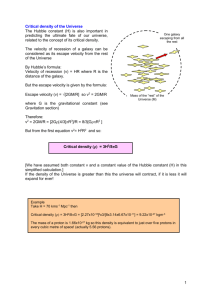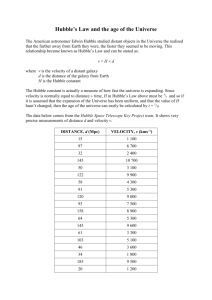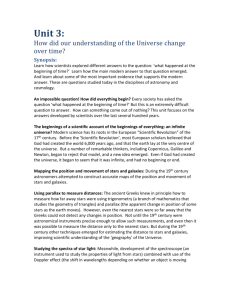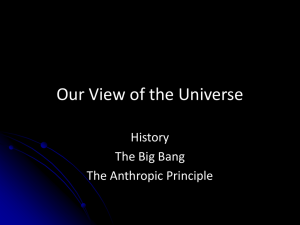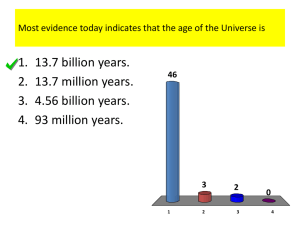MS Word
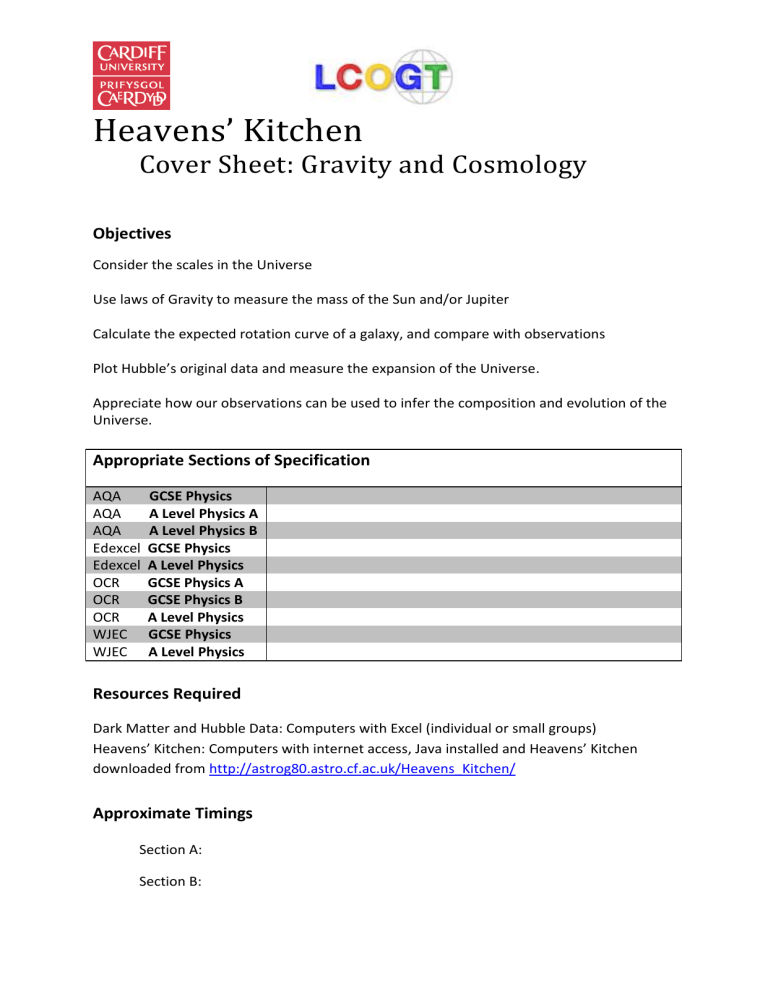
Heavens’ Kitchen
Cover Sheet: Gravity and Cosmology
Objectives
Consider the scales in the Universe
Use laws of Gravity to measure the mass of the Sun and/or Jupiter
Calculate the expected rotation curve of a galaxy, and compare with observations
Plot Hubble’s original data and measure the expansion of the Universe.
Appreciate how our observations can be used to infer the composition and evolution of the
Universe.
Appropriate Sections of Specification
AQA GCSE Physics
AQA A Level Physics A
AQA A Level Physics B
Edexcel GCSE Physics
Edexcel A Level Physics
OCR GCSE Physics A
OCR GCSE Physics B
OCR A Level Physics
WJEC GCSE Physics
WJEC A Level Physics
Resources Required
Dark Matter and Hubble Data: Computers with Excel (individual or small groups)
Heavens’ Kitchen: Computers with internet access, Java installed and Heavens’ Kitchen downloaded from http://astrog80.astro.cf.ac.uk/Heavens_Kitchen/
Approximate Timings
Section A:
Section B:
Section C:
Section D:
Section E:
Section F:
A . 1 Scales in the Universe
Use the ‘Scales’ worksheet to consider the scales in the Universe.
This could be used in conjunction with a physical or hands-on model.
B.
The Mass of the Sun and Jupiter
Use Newton’s laws of Gravity, Kepler’s laws, and the basic properties of the Earth’s orbit, to measure the mass of the Sun. The derivation of the relevant equations is provided in the
‘Mass of the Sun’ worksheet, though more able students may be able to derive these themselves.
The same principle can be used to measure the mass of Jupiter, using observations of the orbits of its satellites. The observations are obtained using the freely available Stellarium planetarium software.
The ‘Mass of Jupiter’ worksheet contains the appropriate instructions. This activity requires the conversion from astronomical units to SI units, and from years to seconds.
C.
Dark Matter and Galaxies
The same principle as in Sections B and C is used to predict the rotation speed of galaxies as at a range of radii. It is suggested that groups calculate different values, and a graphs is plotted as a class. This involves converting units from astronomical
The reverse procedure is used to deduce the mass of a galaxy based on observations of its rotation speed.
Note that in the first part the mass of the galaxy is assumed to be entirely in its centre. This is not an accurate model. More able students may be able to consider a more complex model, such as a uniform density disc with radius of 50,000 light years.
This activity requires the conversion from light years and parsecs to SI units.
D.
Expansion of the Universe
The first worksheet of the ‘Hubble data’ spreadsheet contains the data published by Edwin
Hubble in 1929 to prove the expansion of the Universe. By plotting a line of best fit between the velocity and distance, Hubble’s constant. The value as calculated from this data is around 400 km/s/Mpc – significantly higher that the modern value.
Hubble’s data was relatively inaccurate, and was biased because it was based only on local galaxies. The second worksheet contains more modern measurements of ‘Type 1a’ supernovae in much more distant galaxies. The same exercise as above can be performed, and a more accurate value for Hubble’s constant calculated (around 70 km/s/Mpc).
The third worksheet contains data out to much larger distances, showing that the situation at larger distances is different.
The “A level” version of the spreadsheet requires calculations to derive the distance and apparent velocity from the observed values: the “distance modulus”, which is the dimming of the light relative to more local supernovae; and the redshift, which is the amount by which the wavelength of the light has been stretched by the expansion of the Universe).
A subtlety is that the recession velocity is only an apparent velocity, caused by the expansion of the Universe, which is why the velocity appears to be faster than the speed of light at large distances. This means that Hubble’s Law only applies at low redshifts (relatively small distances). The shape of the curve plotted in the final part depends on how the rate of expansion of the Universe has changed with time, which in turn depends on the density of the Universe and its composition.
E.
Heavens’ Kitchen
Heavens’ Kitchen allows the user to change the composition of the Universe, with different amounts of matter and dark matter. The software shows how the Universe would look with the chosen parameters, and compares them with the observations of our Universe.
Note that Heavens’ Kitchen asks for the total amount of matter and the fraction of that which is normal matter (as opposed to dark matter). The “Heavens’ Kitchen” worksheet contains a number of questions to guide students if required.
Technical details: Heavens’ Kitchen requires an 800MB file to be downloaded, and for Java to be installed on the computer.
E. Stefan-Boltzmann Law
Graph of L against AT 4 should look as follows:
Although it doesn’t quite pass through the origin, it is a straight line, with gradient =
5.51x10
-8 . The actual value for Stefan-Boltzmann constant is 5.67x10
-8 Wm -2 K -4 , which is quite close!
